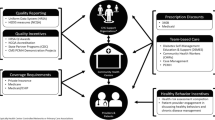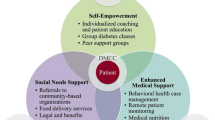Abstract
Purpose of review
In this review, we outline barriers to appropriately caring for high-risk youth with diabetes and discuss efforts in partnering with insurers through Alternative Payment Models to achieve the Triple Aim (improved health, improved care, and reduced costs) for this population.
Recent findings
Current approaches in caring for youth with diabetes who evidence a high degree of social complexity are woefully ineffective. These youth are vulnerable to repeat diabetic ketoacidosis episodes, poor glycemic control, and excessive utilization of healthcare resources. To effectively pursue the Triple Aim, an “integrator” (i.e., an entity that accepts responsibility for all components of the Triple Aim for a specified population) must be identified; however, this does not fit into current fee-for-service models.
Summary
Integrators for youth with diabetes are limited, but early examples of integrator efforts are promising. We present one successful “integrator,” Novel Interventions in Children’s Healthcare (NICH), and detail this program’s efforts in partnering with insurers to serve high-risk youth with diabetes.

Similar content being viewed by others
References
Papers of particular interest, published recently, have been highlighted as: • Of importance •• Of major importance
IHI Triple Aim initiative. In: Institute for healthcare improvement. 2016. http://www.ihi.org/engage/initiatives/tripleaim/pages/default.aspx. Accessed 15 Dec 2016.
Berwick DM, Nolan TW, Whittington J. The Triple Aim: care, health, and cost. Health Aff. 2008;27:759–69.
Wagner DV, Stoeckel ME, Tudor M, Harris MA. Treating the most vulnerable and costly in diabetes. Curr Diab Rep. 2015;15:32–8.
Rivkees SA, Daniels SR. When policy, demographics, and disease collide: the penalty of poor diabetes care in immigrant children. Ped Research. 2016;80:328–9.
Modi AC, Pai AL, Hommel KA, Hood KK, Cortina S, Hilliard ME, et al. Pediatric self-management: a framework for research, practice, and policy. Pediatrics. 2012;129:473–85.
• 2014 Diabetes health care cost and utilization report. Health care cost institute. 2016. http://www.healthcostinstitute.org/report/2014-diabetes-health-care-cost-utilization-report/. Accessed 21 Dec 2016. This paper provides the most updated trends in health care spending and utilization for the US population with diagnosed diabetes.
Mays GP. Health care, employers and population health. Health Management and Policy Presentations. Paper 138. 2016. http://uknowledge.uky.edu/hsm_present/138. Accessed 21 Dec 2016.
May C, Montori V, Mair F. We need minimally disruptive medicine. BMJ. 2009;339:b2803.
Harris MA, Wagner DV, Heywood M, Hoehn D, Bahia H, Spiro K. Youth repeatedly hospitalized for DKA: proof of concept for Novel Interventions in Children’s Healthcare (NICH). Diabetes Care. 2014;37:e125–6.
American Diabetes Association. Economic costs of diabetes in the U.S. in 2012. Diabetes Care. 2013;36:1033–46.
Shrestha SS, Zhang P, Albright A, Imperatore G. Medical expenditures associated with diabetes among privately insured US youth in 2007. Diabetes Care. 2011;34:1097–101.
Miller GF, Coffield E, Leroy Z, Wallin R. Prevalence and costs of five chronic conditions in children. J Sch Nurs. 2016.
Patterson CC, Dahlquist GG, Gyürüs E, Green A, Soltész G, EURODIAB Study Group. Incidence trends for childhood type 1 diabetes in Europe during 1989-2003 and predicted new cases 2005-20: a multicentre prospective registration study. Lancet. 2009;373:2027–33.
D’Adamo E, Caprio S. Type 2 diabetes in youth: epidemiology and pathophysiology. Diabetes Care. 2011;34:161–5.
Secrest AM, Becker DJ, Kelsey SF, LaPorte RE, Orchard TJ. Cause-specific mortality trends in a large population-based cohort with long-standing childhood-onset type 1 diabetes. Diabetes. 2010;59:3216–22.
United States Government Accountability Office. MEDICAID: a small share of enrollees consistently accounted for a large share of expenditures. 2015. http://www.gao.gov/assets/680/670112.pdf. Accessed 21 Dec 2016.
Charron-Prochownik D, Kovacs M, Obrosky DS, Stiffler L. Biomedical and psychosocial predictors of early rehospitalization among children with insulin-dependent diabetes mellitus: a longitudinal study. Diabetes Med. 1994;11:372–7.
Kennan HT, Foster CM, Bratton SL. Social factors associated with prolonged hospitalization among diabetic children. Pediatrics. 2002;109:40–4.
Randall L, Begovic J, Hudson M, Smiley D, Peng L, Pitre N, et al. Recurrent diabetic ketoacidosis in inner-city minority patients: behavioral, socioeconomic, and psychosocial factors. Diabetes Care. 2011;34:1891–6.
La Greca AM, Swales T, Klemp S, Madigan S, Skler J. Adolescents with diabetes: gender differences in psychosocial and glycemic control. Child Health Care. 1995;24:61–78.
Anderson RJ, Grigsby AB, Freedland KE, et al. Anxiety and poor glycemic control: a meta-analytic review of the literature. Int J Psychiatry Med. 2002;32:235–47.
Harris MA, Hood KK, Weissberg-Benchell J. Teens with diabetes: a clinician’s guide. Alexandria: American Diabetes Association; 2014.
Lancaster BM, Gadaire DM, Holman K, LeBlanc LA. Association between diabetes treatment adherence and parent–child agreement regarding treatment responsibilities. Fam Syst Health. 2015;33:120–5.
Hilliard ME, Wu YP, Rausch J, Dolan LM, Hood KK. Predictors of deteriorations in diabetes management and control in adolescents with type 1 diabetes. J Adolesc Health. 2013;52:28–34.
Arthur KC, Lucenko BA, Sharkova IV, et al. Social complexity and suboptimal health care utilization: a marker of need for care coordination? Platform presented at the Annual Meeting of the Pediatric Academic Societies; April 25–28, 2015; San Diego, CA.
Schrager SM, Arthur KC, Nelson J, Edwards AR, Murphy JM, Mangione-Smith R, et al. Development and validation of a method to identify children with social complexity risk factors. Pediatrics. 2016;138, e20153787.
American Diabetes Association. Standards of Medical Care in Diabetes—2012. Diabetes Care. 2012;35:11–63.
National Institute for Clinical Excellence. Type 1 diabetes: diagnosis and management of type 1 diabetes in children, young people and adults. London: National Institute for Clinical Excellence; 2004.
Craig ME, Twigg SM, Donaghue KC, Cheung N, Cameron F, Conn J, et al. National evidence-based clinical care guidelines for type 1 diabetes for children, adolescents and adults. Canberra: Australian Government Department of Health and Aging; 2011.
•• Alternative Payment Model Framework and Progress Tracking (APM FPT) Work Group. Final White Paper. 2016. https://hcp-lan.org/workproducts/apm-whitepaper.pdf. Accessed 21 Dec 2016. This white paper provides an alternative payment model (APM) framework that can be used to track progress toward payment reform. A federally funded research and development center was asked to convene this large national initiative, from which the authors of this paper (“the Work Group”) and this paper were assembled.
Daly R. HHS meets quality, alternative payment goals early. Healthc Financ Manage. 2016;70:11–4.
Centers for Medicare and Medicaid Services. Better care. Smarter spending. Healthier people: paying providers for value, not volume. 2015. https://www.cms.gov/Newsroom/MediaReleaseDatabase/Fact-sheets/2015-Fact-sheets-items/2015-01-26-3.html. Accessed 14 Dec 2016.
Rosenkrantz AB, Nicola GN, Hirsch JA. Anticipated impact of the 2016 Federal election on Federal health care legislation. J Am Coll Radiol. 2017.
Farmer SA, Shalowitz J, George M, McStay F, Patel K, Perrin J, et al. Fully capitated payment breakeven rate for a mid-size pediatric practice. Pediatrics. 2016;e20154367
Zhang P, Shrestha S. Estimating the costs of diabetes by episodes of care: promises and challenges. J Diabetes Complications. 2015;29:463–4.
Kanter MH, Lindsay G, Bellows J, Alide C. Complete care at Kaiser Permanente: transforming chronic and preventive care. Jt Comm J Qual Saf. 2013;39:484–94.
Katon WJ, Lin EH, Von Korff M, Ciechanowski P, Ludman EJ, Young B, et al. Collaborative care for patients with depression and chronic illness. NEJM. 2010;363:2611–20.
California Medi-Cal Type 2 Diabetes Study Group. Closing the gap: effect of diabetes case management on glycemic control among low-income ethnic minority populations: the California Medi-Cal type 2 diabetes study. Diabetes Care. 2004;27:95–103.
Van Walleghem N, Macdonald CA, Dean HJ. Evaluation of a systems navigator model for transition from pediatric to adult care for young adults with type 1 diabetes. Diabetes Care. 2008;31:1529–30.
Cadario F, Prodam F, Bellone S, et al. Transition process of patients with type 1 diabetes (T1DM) from paediatric to the adult health care service: a hospital-based approach. Clin Endocrinol. 2009;71:346–50.
Treadwell J, Perez R, Stubbs D, McAllister JW, Stern S, Buzi R. Case management and care coordination: supporting children and families to optimal outcomes. Springer International Publishing; 2014; p. 107-15.
Berry JG, Agrawal RK, Cohen E, Kuo DZ. The landscape of medical care for children with medical complexity. Overland Park: Children’s Hospital Association; 2013.
Brown SA, García AA, Winter M, Silva L, Brown A, Hanis CL. Integrating education, group support, and case management for diabetic Hispanics. Ethn Dis. 2011;21:20–6.
Bojadzievski T, Gabbay RA. Patient-centered medical home and diabetes. Diabetes Care. 2011;34:1047–53.
Rosenthal TC. The medical home: growing evidence to support a new approach to primary care. J Am Board Fam Med. 2008;21:427–40.
Cooley WC, McAllister JW, Sherrieb K, Kuhlthau K. Improved outcomes associated with medical home implementation in pediatric primary care. Pediatrics. 2009;124:358–64.
Drummond A, Looman W, Phillips A. Coping among parents of children with special health care needs with and without a health care home. J Pediatr Health Care. 2012;26:266–75.
Raphael JL, Cooley WC, Vega A, et al. Outcomes for children with chronic conditions associated with parent-and provider-reported measures of the medical home. J Health Care Poor Underserved. 2015;26:358–76.
Katz ML, Laffel LM, Perrin JM, Kuhlthau K. Impact of type 1 diabetes mellitus on the family is reduced with the medical home, care coordination, and family-centered care. J Pediatr. 2012;160:861–7.
Korenstein D, Duan K, Diaz MJ, Ahn R, Keyhani S. Do health care delivery system reforms improve value? The jury is still out. Med Care. 2016;54:55–6.
Sheiman I. Integrated health care payment methods: typology, evidence and pre-conditions of implementation. Higher School of Economics Research Paper No. WP BRP. 2014 Sep 25;18
Berenson RA, Upadhyay DK, Delbanco SF, Murray R. Payment methods and benefit designs: how they work and how they work together to improve healthcare. A typology of payment methods. 2016. http://www.urban.org/research/publication/typology-payment-methods/view/full_report. Accessed 15 Dec 2016.
Beck JK, Logan KJ, Hamm RM, et al. Reimbursement for pediatric diabetes intensive case management: a model for chronic diseases? Pediatrics. 2004;113:e47–50.
• Harris MA, Spiro K, Heywood M, Wagner DV, Hoehn D, Hatten A, et al. Novel Interventions in Children’s Health Care (NICH): innovative treatment for youth with complex medical conditions. Clin Pract Pediatr Psychol. 2013;2:137–45. This study provides a more detailed description of the NICH program, which was used as a primary example of an “integrator” in the present review. This paper includes the theoretical and empirical underpinnings of the intervention, along with a case example.
Harris MA, Wagner DV, Heywood M, Hartman A, Harris J, Barry S, Rogers B. Youth repeatedly hospitalized for DKA: NICH work(s)! [Abstract]. Diabetes. 2016; 76.
McConnell KJ, Chang AM, Cohen DJ, et al. Oregon’s Medicaid transformation: an innovative approach to holding a health system accountable for spending growth. Healthc (Amst). 2014;2(3):163–7.
Brown B, Crapo J, The key to transitioning from fee-for-service to value-based reimbursement. 2014. https://www.healthcatalyst.com/hospital-transitioning-fee-for-service-value-based-reimbursements. Accessed 20 Dec 2016
McCarthy D, Ryan J, Klein S. Models of care for high-need, high-cost patients: an evidence synthesis. Issue Brief (Commonw Fund). 2015;31:1–19.
Wagner DV, Borduin CM, Sawyer AM, Dopp AR. Long-term prevention of criminality in siblings of serious and violent juvenile offenders: a 25 year follow-up to a randomized clinical trial of multisystemic therapy. J Consult Clin Psychol. 2014;82(3):492.
Fordatch MS, Patterson GR, Degarmo DS, Beldavs ZQ. Testing the Oregon delinquency model with 9-year follow-up of the Oregon Divorce Study. Dev Psychopathol. 2009;21(02):637–60.
Author information
Authors and Affiliations
Corresponding author
Ethics declarations
Conflict of Interest
Samantha A. Barry, Lena Teplitsky, David V. Wagner, Amit Shah, Brian T. Rogers, and Michael A. Harris declare that they have no conflict of interest.
Human and Animal Rights and Informed Consent
This article does not contain any studies with human or animal subjects performed by any of the authors.
Additional information
This article is part of the Topical Collection on Psychosocial Aspects
Rights and permissions
About this article
Cite this article
Barry, S.A., Teplitsky, L., Wagner, D.V. et al. Partnering with Insurers in Caring for the Most Vulnerable Youth with Diabetes: NICH as an Integrator. Curr Diab Rep 17, 26 (2017). https://doi.org/10.1007/s11892-017-0849-4
Published:
DOI: https://doi.org/10.1007/s11892-017-0849-4




